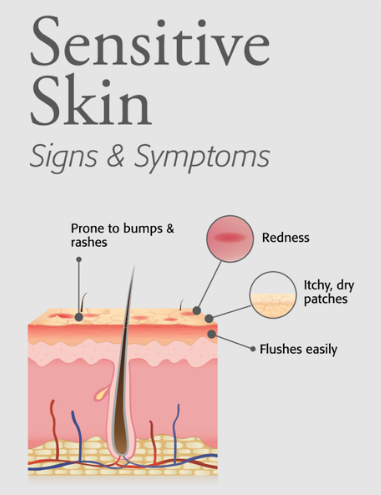
Does your skin have a sensitive side? Caring for this skin type can be a struggle – and choosing the right skin care treatments and products can feel like rolling the dice. One misstep and you could aggravate your temperamental complexion, bringing about a variety of uncomfortable symptoms. Here is everything you need to know about sensitive skin, as well as our tips for keeping it calm, cool and collected.

What Is Sensitive Skin?
With its wide variety of symptoms, sensitive skin does not manifest the same way for everyone. Its severity can range from moderate discomfort to severe reactions, and its frequency can fluctuate from the occasional flare-up to more persistent, daily sensitivity.
If you find your skin is easily irritated by environmental stressors like sun, wind and pollution, and/or topical products like lotions or fragrances, you may have sensitive skin.
Sensitive skin is typically described as skin that endures the regular occurrence of unpleasant sensations such as heat, stinging, burning and tingling caused by forms of stimulation that wouldn’t normally create this type of reaction in a ‘normal’ skin type. If you find your skin is easily irritated by environmental stressors like sun, wind and pollution, and/or topical products like lotions or fragrances, you may have sensitive skin.
Irritant Sensitivity Vs Allergic Sensitivity
There are two different types of sensitivity – irritant sensitivity and allergic sensitivity.
An irritant sensitivity is something that irritates everyone’s skin and is independent of your immune system. Although most skin reacts to an irritant, someone with sensitive skin would see a more dramatic reaction. These symptoms may include itchiness, redness, dryness, rashes, or breakouts. In comparison, an allergic sensitivity is dependent on your immune system, and it requires a prior exposure to the allergen. Because an allergic sensitivity is due to each specific immune system, unlike an irritant sensitivity, only a portion of the population is impacted.
Regardless of the causes, sensitive skin is a skin type, caused by a genetic predisposition to skin sensitivity and irritation. It’s also a common symptom of genetic conditions like psoriasis, eczema and rosacea. You can’t change your skin type, but you can adjust your daily habits and skin care routine to manage its symptoms.
How To Know If You Have Sensitive Or Sensitized Skin
Another point of confusion with your potentially sensitive skin is whether it’s sensitive at all – or whether it’s actually sensitized. Sensitized skin is a skin condition, which is characterized by skin irritation that builds over time due to environmental influences and lifestyle choices. Some of the biggest factors causing sensitized skin are pollution, stress and alcohol consumption. Unlike sensitive skin, the symptoms of sensitized skin can be “fixed” over time with targeted skin care treatments and lifestyle changes.
Sensitive and sensitized skin share a key characteristic – a compromised lipid barrier. Your skin’s lipid barrier is its protective, fatty outer layer that performs two functions: It keeps water in and environmental stressors (like UV rays, harsh chemicals and pollution) out. You can think of your skin barrier like a brick wall put together with mortar between the skin cells. In sensitive or sensitized skin, that mortar has been weakened and is more permeable. When an irritant sneaks through the lipid barrier, your immune system issues an inflammatory response. That response – characterized by redness, pain and itching – is what you experience as sensitivity.
Sensitive Skin Symptoms & Signs
Signs of sensitive and sensitized skin also overlap. However, sensitized skin symptoms often disappear once its lipid barrier has been repaired, while in sensitive skin they tend to be more persistent. Both display a range of symptoms that occur minutes to hours after contact with a particular ingredient or environmental trigger. Here are five telltale signs of sensitive skin:
1. Flushes Easily
Whether your face turns red after cleansing or just from facing a gust of chilly wind, your skin’s propensity to flush is a sign that its barrier function is compromised. Whether your face turns red after cleansing or just from facing a gust of chilly wind, your skin’s propensity to flush is a sign that its barrier function is compromised. This redness is due to an inflammatory response from your immune system. In an attempt to heal, blood rushes to the surface of your sensitive skin.
2. Prone To Rashes & Bumps
When sensitive skin on the face is exposed to a trigger, it will often react with a red, flaky or bumpy rash. Healthgrades says this is especially true for topical products like facial serums and moisturizers that are meant to be left on the skin rather than rinsed off.
3. Itchy
In addition to rashes and bumps, sensitive skin may feel itchy and tight – particularly after cleansing with products that contain harsh chemicals or artificial fragrances. It’s often accompanied by dryness and/or dehydration, which can also leave skin feeling prickly and parched.
4. Beauty Products Sting Or Burn
You know you have sensitive skin if the majority of the products you place on your skin causes stinging or redness. Because sensitive skin has a broken lipid barrier, fragrances and active ingredients can penetrate more easily and deeply, causing a stinging, burning or prickling sensation.
5. Reacts To Fragrance
Dermatologists agree that fragrance is one of the most notorious causes of skin irritation and sensitivity. From laundry detergents to personal care products, many consumer goods contain synthetic fragrances that can cause a reaction in sensitive skin.
Tips for Sensitive Skin
You may not be able to change your sensitive skin type, but there are several tips you can follow to keep your sensitive skin symptoms under wraps:
1. Avoid Long, Hot Showers
It’s time to swap your long, hot showers for shorter, lukewarm ones. Why? Sensitive skin often reacts negatively to heat exposure which breaks down the skin’s lipid barrier.“Think about it like butter on a knife. If you put it under cold water, the fat on the knife doesn’t go anywhere. But if you put it under warm water, those lipids will melt away. It’s the same kind of issue with the lipid layer in our skin. If you put your skin in hot water or use harsh soaps, then it tends to wash that outer protective fatty layer away.
2. Be Aware Of Triggers
One of the best ways to manage your sensitive skin symptoms is to be aware of the environmental and lifestyle triggers that cause your skin to react. The more you know, the better you can identify them and take precautionary measures. Triggers differ from person to person, but often include:
- Seasonal changes
- Stress and lack of sleep
- Pollution
- Dehydration
3. Skip Harsh Chemicals & Artificial Fragrances
Harsh chemicals and artificial fragrances are two of the biggest contributors to lipid barrier damage. To keep your skin’s health intact, Look for skin care products free from fragrances and paraben preservatives, two common causes of irritation and flare-ups. Choose natural skin care brands like Eminence Organics that do not use parabens, sodium lauryl sulfates, synthetic dyes, petrochemicals and phthalates in their formulations.
4. Choose Calming Ingredients
In addition, reach for products that contain calming ingredients. It’s important to choose natural ingredients when possible, no matter your skin type, but for sensitive skin it is extra important, these products may be described as hypoallergenic, mild or gentle and can contain natural ingredients like coconut oil, aloe vera, chamomile, vitamin E and shea butter.
Ingredients should be chosen for their anti-inflammatory properties and ability to enhance your skin’s lipid barrier. In summary, these include:
- Hyaluronic acid
- Aloe vera
- Vitamin E
- Olive oil
- Chamomile
- Shea butter
- Sunflower seed oil
- Coconut oil
5. Perform A Patch Test
We’ve all been there after a skin care purchase haul. Excitedly trying all the new products at once is something nearly everyone has done at one time or another. But this can lead to an unwanted reaction, particularly for sensitive skin types. Instead, always perform a patch test before adding new products to your skin care routine. Do a test run on a small, inconspicuous patch of skin (like behind your ear) before applying. Wait at least 24 hours for signs of irritation, redness, or other skin freak-outs. If your skin is hypersensitive, repeat this test run on a patch next to your eye. All clear? You’re safe to apply with abandon.
6. Moisturize
One of the best ways to maintain a healthy lipid barrier is to moisturize – day and night. An effective moisturizer will replenish skin’s outer layer and prevent water loss, helping to prevent penetration by potential irritants. When choosing a moisturizer, we recommend looking for ingredients that are high in fatty acids (like shea butter, jojoba oil and coconut oil), as well as humectants (like hyaluronic acid) that work to increase hydration and lock in moisture.
7. Apply SPF
Sensitive skin is extra-responsive to the sun’s rays – and UV protection is a must. We suggest using a mineral sunscreen that contains physical blockers like zinc oxide and titanium dioxide to shield your skin from damaging UV rays.
Professional treatments are important. At Touch to Heal Spa, your esthetician will walk you through the home care products to ensure the products you use at home minimize skin irritation. Use the link below to book an appointment for your sensitive skin facial treatment. Please ensure to book our Custom Organic Facial and make a note about your sensitive skin:
you might also like:
[su_row][su_column size=”1/5″ center=”no” class=””]g [/su_column] [su_column size=”1/5″ center=”no” class=””] [/su_column] [su_column size=”1/5″ center=”no” class=””]
[/su_column] [su_column size=”1/5″ center=”no” class=””]
[/su_column] [su_column size=”1/5″ center=”no” class=””]
[/su_column] [su_column size=”1/5″ center=”no” class=””]
[/su_column] [su_column size=”1/5″ center=”no” class=””]
[/su_column] [su_column size=”1/5″ center=”no” class=””]
gg[/su_column] [/su_row]


